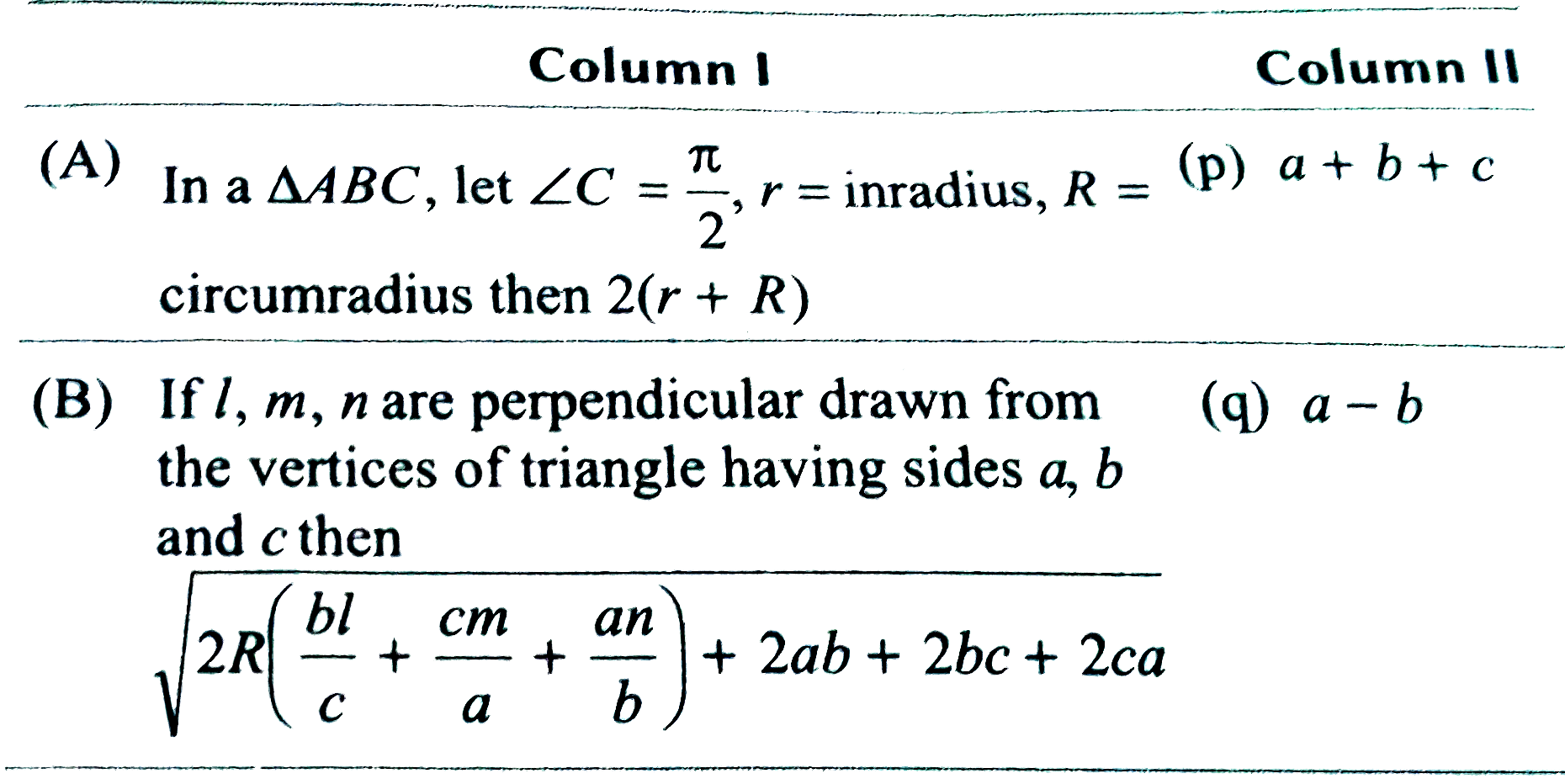Statement I: If in a triangle ABC,sin2A+sin2B+sin2C=2, then one of the angles must be 90∘.
Statement II: In any triangle ABC cos2A+cos2B+cos2C=−1−4cosAcosBcosC
(a) Both Statement I and Statement II are correct and Statement II is the correct explanation of Statement I
(b) Both Statement I and Statement II are correct but Statement II is not the correct explanation of Statement I
(c) Statement I is correct but Statement II is incorrect
(d) Statement II is correct but Statement I is incorrect
The correct Answer is:A
To solve the problem, we need to analyze both statements and determine their validity step by step.
Step 1: Analyze Statement II
We start with Statement II, which claims:
cos2A+cos2B+cos2C=−1−4cosAcosBcosC
Hint: Recall that the sum of angles in a triangle is A+B+C=π.
Using the identity for the cosine of a sum, we can express cos2A and cos2B in terms of A and B:
cos2A=2cos2A−1
cos2B=2cos2B−1
cos2C=2cos2C−1
Substituting these into the left-hand side gives:
(2cos2A−1)+(2cos2B−1)+(2cos2C−1)
This simplifies to:
2(cos2A+cos2B+cos2C)−3
Hint: Use the identity cos2A+cos2B+cos2C=1+2cosAcosBcosC.
Now, we can substitute this identity into our equation:
2(1+2cosAcosBcosC)−3=−1−4cosAcosBcosC
This simplifies to:
2+4cosAcosBcosC−3=−1−4cosAcosBcosC
Thus, we have:
−1+4cosAcosBcosC=−1−4cosAcosBcosC
Adding 4cosAcosBcosC to both sides gives:
0=0
This confirms that Statement II is true.
Step 2: Analyze Statement I
Now we move to Statement I, which claims:
sin2A+sin2B+sin2C=2
Hint: Use the identity sin2A+sin2B+sin2C=2+2cosAcosBcosC.
From Statement II, we have:
sin2A+sin2B+sin2C=2+2cosAcosBcosC
Setting this equal to 2 gives:
2+2cosAcosBcosC=2
This simplifies to:
2cosAcosBcosC=0
Hint: Consider the implications of the product being zero.
Since cosAcosBcosC=0, at least one of the angles A,B, or C must be 90∘ (or π2 radians). This confirms that Statement I is also true.
Conclusion
Both statements are correct, and Statement II correctly explains Statement I. Therefore, the correct answer is:
Option A: Both statements are correct, and Statement II is the correct explanation of Statement I.
We start with Statement II, which claims:
cos2A+cos2B+cos2C=−1−4cosAcosBcosC
cos2A=2cos2A−1
cos2B=2cos2B−1
cos2C=2cos2C−1
(2cos2A−1)+(2cos2B−1)+(2cos2C−1)
This simplifies to:
2(cos2A+cos2B+cos2C)−3
2(1+2cosAcosBcosC)−3=−1−4cosAcosBcosC
This simplifies to:
2+4cosAcosBcosC−3=−1−4cosAcosBcosC
Thus, we have:
−1+4cosAcosBcosC=−1−4cosAcosBcosC
Adding 4cosAcosBcosC to both sides gives:
0=0
This confirms that Statement II is true.
Now we move to Statement I, which claims:
sin2A+sin2B+sin2C=2
sin2A+sin2B+sin2C=2+2cosAcosBcosC
2+2cosAcosBcosC=2
This simplifies to:
2cosAcosBcosC=0
Both statements are correct, and Statement II correctly explains Statement I. Therefore, the correct answer is:
Option A: Both statements are correct, and Statement II is the correct explanation of Statement I.
Topper's Solved these Questions
- PROPERTIES AND SOLUTION OF TRIANGLES Book:ARIHANT MATHS ENGLISHChapter:PROPERTIES AND SOLUTION OF TRIANGLES Exercise:Exercise (Passage Based Questions)
Explore 18 Videos
- PROPERTIES AND SOLUTION OF TRIANGLES Book:ARIHANT MATHS ENGLISHChapter:PROPERTIES AND SOLUTION OF TRIANGLES Exercise:PROPERTIES AND SOLUTIONS OF TRIANGLES EXERCISE 5: MATCHING TYPE QUESTIONS
Explore 3 Videos
- PROPERTIES AND SOLUTION OF TRIANGLES Book:ARIHANT MATHS ENGLISHChapter:PROPERTIES AND SOLUTION OF TRIANGLES Exercise:Exercise (More Than One Correct Option Type Questions)
Explore 23 Videos
- PRODUCT OF VECTORSBook:ARIHANT MATHS ENGLISHChapter:PRODUCT OF VECTORSExercise:Exercise (Questions Asked In Previous 13 Years Exam)
Explore 51 Videos
- SEQUENCES AND SERIESBook:ARIHANT MATHS ENGLISHChapter:SEQUENCES AND SERIESExercise:Exercise (Questions Asked In Previous 13 Years Exam)
Explore 38 Videos
Similar Questions
R is circumradii of ΔABC,H is orthocentre, R1,R2,R3 are circumradii of ΔAHB,ΔBHC. If AH produced meet the circumradii of ABC at M and intersect BC at L,
∠AHB=180∘−C
csin(180∘−C)=2R1
csinC=2R1
R1=R
Area of ΔAHB
View SolutionMatch the statement of Colume I with values of Column II.


View SolutionIf area of ΔABC(Δ) and angle C are given and if c opposite to given angle is minimum, then
View SolutionLet O be the origin and let PQR be an arbitrary triangle. The point S is such that ¯¯¯¯¯¯OP⋅¯¯¯¯¯¯OQ+¯¯¯¯¯¯OR⋅¯¯¯¯¯¯OS=¯¯¯¯¯¯OR⋅¯¯¯¯¯¯OP+¯¯¯¯¯¯OQ⋅¯¯¯¯¯¯OS=¯¯¯¯¯¯OQ⋅¯¯¯¯¯¯OR+¯¯¯¯¯¯OP⋅¯¯¯¯¯¯OS Then the triangle PQR has S as its
View SolutionLet a,b,c be in A.P. and |a|<1,|b|<1|c|<1.ifx=1+a+a2+....to ∞,y=1+b+b2+....to ∞and,z=1+c+c2+...to ∞, then x,y,z are in
View SolutionFor any triangle ABC, prove that acosA+bcosB+ccosC=2asinBsinC
View SolutionIn any triangle ABC , prove that: acosA+bcosB+ccosC=2asinBsinC
View SolutionIn Delta ABC, if sin A+sin B+sin B+sin C=1+sqrt(2) and cos A+cos B+cos C=sqrt(2) then the triangle is
View SolutionIn any ΔABC, prove that : acosA+bcosB+ccosC=2asinBsinC
View SolutionIn any triangle ABC, show that : 2acos(B2)cos(C2)=(a+b+c)sin(A2)
View Solutionकिसी त्रिभुज ABC के लिए , सिद्ध कीजिए कि -
acosA+bcosB+ccosC=2asinBsinC
View Solutionसिध्द कीजिये कि किसी ΔABC में
sin2A+sin2B–sin2C=4cosAcosBsinC
View Solutionकिसी ΔABC में सिध्द कीजिये कि:
(a)cos2A+cos2B+cos2C=−1−4cosAcosBcosC
(b)cos2A+cos2B−cos2C=1−4sinAsinBcosC
View Solutionकिसी ΔABC में सिध्द कीजिये कि:
सिध्द कीजिए कि : sinA+sinBsinC=4cos.A2cos.B2cosC2
View SolutionStatement I In any triangle
acosA+bcosB+ccosC≤s
Statement II In any triangle sin(A2)sin(B2)sin(C2)≤18
View SolutionIf A, B, C are angles of a triangle , prove that cos2A+cos2B−cos2C=1−4sinAsinBcosC
View Solution
